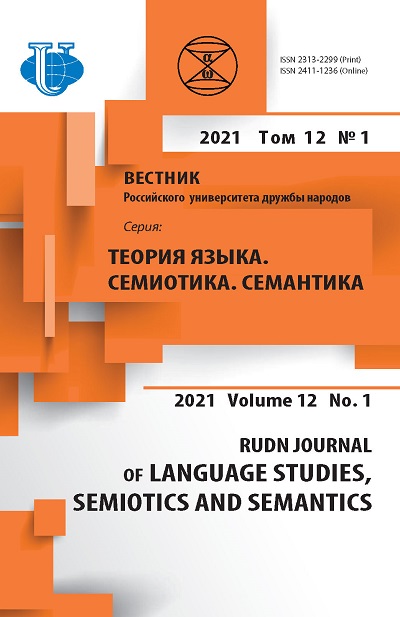Illocutionary Compulsion as a Sign of Pseudocommunication
- Authors: Ponomaryova I.V.1
-
Affiliations:
- Tver State University
- Issue: Vol 12, No 1 (2021)
- Pages: 61-70
- Section: FUNCTIONAL GRAMMAR & FUNCTIONAL SEMANTICS
- URL: https://journals.rudn.ru/semiotics-semantics/article/view/25805
- DOI: https://doi.org/10.22363/2313-2299-2021-12-1-61-70
Cite item
Full Text
Abstract
The study is timely and actual, since at present, due to the aggravation of interethnic and interstate relations, it is necessary to study discursive mechanisms, taking into account which would more successfully develop methods and models of dialogical discourse, formulate criteria and choose adequate means of carrying out dialogical activities at different levels of communication. The purpose of the study is to identify the features of dialogical speech in ineffective communication situations. The dialogical discourse fragments extracted by applying continuous sampling method the 20th century fiction which served as the material of the study. The methods of contextual analysis, interactional and intentional analysis were used in the study. The research allows comprehend from a linguistic point of view the regulation process of speech behavior of the dialogical interaction participants, to deepen the knowledge of nature and features of speech communication. Illocutionary compulsion is considered to be creating conditions by the communicant when the communicative partner is forced to participate in the communicative process contrary to the will and desire. The factor of illocutionary compulsion means dialogic interaction infringement on the communicative level, performing communicative characteristics of the dialogical discourse and determining the unity of the content aspect of the dialogical interaction; on the interactive level, which determines the interconnectedness of speech actions in communication; and on the perceptual level, associated with the personal socio-psychological and emotional-expressive characteristics of the communicants. On the communicative level such violations mean inconsistency of communicative intentions and strategies of the partners, inadequacy of the illocutionary focus, both structural and semantic incompatibility of replicas of partners, uninformativeness, unactuality, insignificance of messages within the dialogical interaction, violation of the principles governing speech communication. On the interactive level, such violations are manifested as the lack of interaction synchronization of speech actions of the communicants, non-focus of the partners’ actions on correlating the goals of each of the parties and on organizing their achievement, the lack of connection between speech courses and the lack of verbal and non-verbal signals providing interaction regulation. On the perceptual level such violations are incompatibility of peculiarities of worldview and world perception of the communicants, inadequacy of perception, interpretation and assessment of communicative partners of each other, inconsistency in motivation for actions, inadequate tonality of communication, incompatibility of expression of an emotional state and psychological mood. Thereby the factor of illocutionary compulsion promotes the formation of pseudocommunicative contacts situations. The process does not lead to the jointly created result, since it is carried out exclusively as a speaking process. The phenomenon of the pseudocommunicative contact includes various types of other negative phenomena and is characterized by the lack of general communicative meaning. The communication is made as a process but not a result therefore it is considered as unsuccessful, ineffective and unpromising
About the authors
Inna V. Ponomaryova
Tver State University
Author for correspondence.
Email: ivponomaryova@mail.ru
Candidate of Philology, Associate Professor of the Department of the Foreign Languages for Natural Faculties
33, Zhelyabova str., Tver, Russian Federation, 170100References
- Humboldt, W. von. (1984). Selected Works on Linguistics. Moscow: Progress. (In Russ.).
- Gubman, B.L. (1995). Introduction to the philosophy of culture. Tver: Tver State University. (In Russ.).
- Heidegger, M. (1999). Being and Time. Oxford: MPG Books Ltd.
- Habermas, J. (1987). The Theory of Communicative Action. Frankfurt am Main.
- Susov, I.P. (2009). Linguistic pragmatics. Moscow: Vostok-Zapad. (In Russ.).
- Starichenok, V.D. (2008). The big linguistic dictionary. Rostov-on-Don. (In Russ.).
- Strawson, P.F. (1964). Intention and Convention in Speech Acts. The Philosophical Review, 4, 439—460.
- Ryzhova, L.P. (2007). French pragmatics. Moscow: Nauka. (In Russ.).
- Ushakov, D.N. (2000). Explanatory dictionary of the Russian language: Vol. 1. Moscow: AST Publishing House. (In Russ.).
- Laplanche, Zh. (1996). Dictionary of Psychoanalysis. Moscow: Vysshaja shkola. (In Russ.).
- Kravtsov, S.I. (2003). Big Russian encyclopedia. Moscow: Big Russian Encyclopedia. (In Russ.).
- Beckett, S. (1986). Happy days. The complete dramatic works. London, Boston. pp. 137—159.
- Ionesco, E. (1954). La cantatrice chauve. Editions Gallimard. pp. 11—14.













